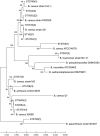Characterization and spoilage potential of Bacillus cereus isolated from farm environment and raw milk
- PMID: 36177462
- PMCID: PMC9514233
- DOI: 10.3389/fmicb.2022.940611
Characterization and spoilage potential of Bacillus cereus isolated from farm environment and raw milk
Abstract
Bacillus cereus sensu lato (B. cereus sl) is important spoilage bacteria causing milk structure and flavor changes and is ubiquitous in the environment. This study addresses the biodiversity, toxicity, and proteolytic activity of B. cereus sl from 82 environmental samples and 18 raw bovine milk samples from a dairy farm in the region of Tianjin. In sum, 47 B. cereus sl isolates were characterized through biochemical tests, 16S rRNA gene sequencing, and panC gene analysis. Fourteen sequence types (STs) of B. cereus sl were found in raw bovine milk samples, and five new STs (ST2749, ST2750, ST2751, ST2752, and ST2753) were identified in this study. ST1150 was the dominant ST, associated with fecal, air, drinking water, teat skin, teat cup, and teat dip cup. The results of toxin gene analyses showed that 12.77% and 8.51% of isolates carried hblACD and nheABC operons, respectively. In addition, the detection rate of emetic cesB gene was 21.28%. B. cereus sl demonstrated high spoilage potentials even at 7°C, which has the proteolytic activity of 14.32 ± 1.96 μmol of glycine equivalents per ml. Proteolytic activities were significantly (p < 0.05) decreased after the heat treatment. The residual activity of protease produced at 7°C was significantly higher than that produced at 25°C and 37°C after treatment at 121°C for 10 s and 135°C for 5 s (p < 0.01). Together, the results provide insights into the characteristics of B. cereus sl from farm environment and raw bovine milk and revealed that B. cereus sl contamination should also be monitored in raw milk for ultra-high temperature (UHT) products. This knowledge illustrates that strict cleaning management should be implemented to control B. cereus sl and assure high-quality milk products.
Keywords: B. cereus sl; MLST; dairy farm; proteolytic activity; toxin genes.
Copyright © 2022 Meng, Zhang, Dong, Hu, Liu, Zheng, Wang and Cheng.
Conflict of interest statement
The authors declare that the research was conducted in the absence of any commercial or financial relationships that could be construed as a potential conflict of interest.
Figures



Similar articles
-
Characterization of Bacillus cereus sensu lato isolates from milk for consumption; phylogenetic identity, potential for spoilage and disease.Food Microbiol. 2021 Feb;93:103604. doi: 10.1016/j.fm.2020.103604. Epub 2020 Aug 13. Food Microbiol. 2021. PMID: 32912579
-
Prevalence, molecular characterization, and antibiotic susceptibility of Bacillus cereus isolated from dairy products in China.J Dairy Sci. 2020 May;103(5):3994-4001. doi: 10.3168/jds.2019-17541. Epub 2020 Feb 26. J Dairy Sci. 2020. PMID: 32113767
-
Prevalence, virulence factor genes and antibiotic resistance of Bacillus cereus sensu lato isolated from dairy farms and traditional dairy products.BMC Microbiol. 2017 Mar 14;17(1):65. doi: 10.1186/s12866-017-0975-9. BMC Microbiol. 2017. PMID: 28288581 Free PMC article.
-
Application of a novel amplicon-based sequencing approach reveals the diversity of the Bacillus cereus group in stored raw and pasteurized milk.Food Microbiol. 2019 Aug;81:32-39. doi: 10.1016/j.fm.2018.01.014. Epub 2018 Feb 1. Food Microbiol. 2019. PMID: 30910086
-
The Biodiversity of the Microbiota Producing Heat-Resistant Enzymes Responsible for Spoilage in Processed Bovine Milk and Dairy Products.Front Microbiol. 2017 Mar 1;8:302. doi: 10.3389/fmicb.2017.00302. eCollection 2017. Front Microbiol. 2017. PMID: 28298906 Free PMC article. Review.
Cited by
-
Characterization of the Bacillus cereus Group Isolated from Ready-to-Eat Foods in Poland by Whole-Genome Sequencing.Foods. 2024 Oct 14;13(20):3266. doi: 10.3390/foods13203266. Foods. 2024. PMID: 39456328 Free PMC article.
-
Bacillus cereus in the Artisanal Cheese Production Chain in Southwestern Mexico.Microorganisms. 2023 May 15;11(5):1290. doi: 10.3390/microorganisms11051290. Microorganisms. 2023. PMID: 37317264 Free PMC article.
-
Development of A Novel EvaGreen-Dye Based Recombinase Aided Amplification Assay Using Self-Avoiding Molecular Recognition System Primers.China CDC Wkly. 2025 Apr 4;7(14):482-488. doi: 10.46234/ccdcw2025.079. China CDC Wkly. 2025. PMID: 40376447 Free PMC article.
-
Isolation of Bacillus cereus Group from the Fecal Material of Turtles.MicroPubl Biol. 2025 May 26;2025:10.17912/micropub.biology.001587. doi: 10.17912/micropub.biology.001587. eCollection 2025. MicroPubl Biol. 2025. PMID: 40496642 Free PMC article.
-
A comprehensive analysis of chemical and biological pollutants (natural and anthropogenic origin) of soil and dandelion (Taraxacum officinale) samples.PLoS One. 2023 Jan 20;18(1):e0280810. doi: 10.1371/journal.pone.0280810. eCollection 2023. PLoS One. 2023. PMID: 36662824 Free PMC article.
References
-
- Alonso V.P. P., De Oliveira Morais J., Kabuki D. Y. (2021). Incidence of Bacillus cereus, Bacillus sporothermodurans and Geobacillus stearothermophilus in ultra-high temperature milk and biofilm formation capacity of isolates. Int. J. Food Microbiol. 354, 109318. 10.1016/j.ijfoodmicro.2021.109318 - DOI - PubMed
-
- Benahmed M., Leguerinel I., Moussa-Boudjemaa B. (2020). Biodiversity, spoilage capacity and heat resistance ofmesophilic aerobic spores isolated from milk powdersmarketed in Algeria. Int. J. Dairy Technol. 73, 771–780. 10.1111/1471-0307.12715 - DOI
LinkOut - more resources
Full Text Sources
Molecular Biology Databases

